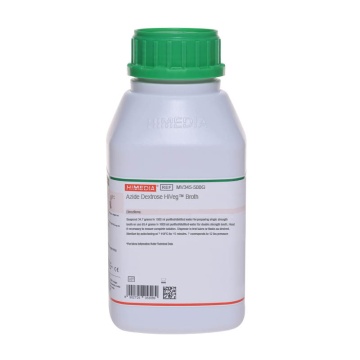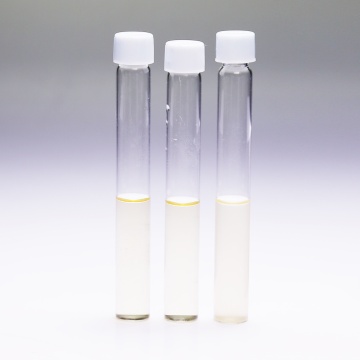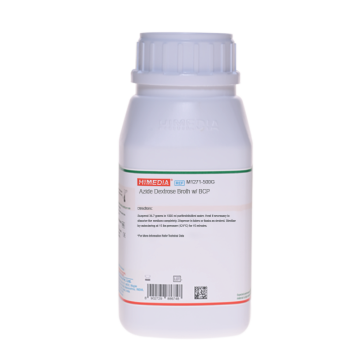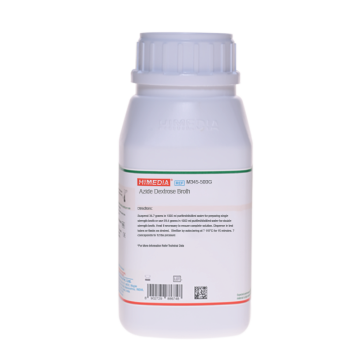 Your enquiry has been submitted
Your enquiry has been submitted
Azide Dextrose Broth, Modified
Intended Use
Recommended for the detection of Enterococci in water.
Composition**
| Ingredients | Gms / Litre |
|---|---|
| Peptone | 20.000 |
| Dextrose (Glucose) | 5.000 |
| Sodium chloride | 5.000 |
| Dipotassium hydrogen phosphate | 2.700 |
| Potassium dihydrogen phosphate | 2.700 |
| Sodium azide | 0.200 |
Final pH ( at 25°C): 6.8±0.2
**Formula adjusted, standardized to suit performance parameters
Directions
Suspend 35.6 grams in 1000 ml purified / distilled water. Heat if necessary to dissolve the medium completely. Dispense into tubes or flasks as desired. Sterilize by autoclaving at 15 lbs pressure (121°C) for 15 minutes.
Principle And Interpretation
Azide Dextrose Broth, modified is used for the detection of enterococci in water and sewage (3). Enterococci are more resistant to chlorine in water, hence are better indicators of sewage pollution than Escherichia coli. Azide Dextrose Broth was initially formulated by Rothe, Mallmann and Seligmann (7,8) for quantitative determination of enterococci in water, foods, sewage and other materials suspected of contamination with sewage.
Peptone provides nitrogen, amino acids, vitamins and other minerals required for growth. Dextrose (Glucose) serves as source of carbon. Sodium chloride maintains osmotic equilibrium. Sodium azide inhibits growth of Gram-negative organisms allowing enterococci to grow (2,4,7), and the concentration selected provides optimum protection for the enterococci while largely suppressing the Gram-negative flora. The phosphate buffer system controls pH.
Type of specimen
Water samples
Specimen Collection and Handling
For water samples, follow appropriate techniques for sample collection, processing as per guidelines and local standards(1). After use, contaminated materials must be sterilized by autoclaving before discarding.
Warning and Precautions
Read the label before opening the container. Wear protective gloves/protective clothing/eye protection/face protection. Follow good microbiological lab practices while handling specimens and culture. Standard precautions as per established guidelines should be followed while handling specimens. Safety guidelines may be referred in individual safety data sheets.
Limitations
- Further confirmation by biochemical and serological testing must be carried out on colonies from pure culture.
- Some organism may show poor growth due to nutritional variation.
Performance and Evaluation
Performance of the medium is expected when used as per the direction on the label within the expiry period when stored at recommended temperature.
Quality Control
Appearance: Cream to yellow homogeneous free flowing powder
Colour and Clarity of prepared medium: Yellow coloured clear solution without any precipitate.
Reaction: Reaction of 3.56% w/v aqueous solution at 25°C. pH : 6.8±0.2
Cultural Response: Cultural characteristics observed after an incubation at 35-37°C for 18-24 hours
| Organism | Inoculum (CFU) | Growth |
|---|---|---|
| Escherichia coli ATCC 25922 (00013*) | >=10⁴ | inhibited |
| Enterococcus faecalis ATCC 29212 (00087*) | 50-100 | good-luxuriant |
Key : (*) Corresponding WDCM numbers.
Storage and Shelf Life
Store between 10-30°C in a tightly closed container and the prepared medium at 15-25°C. Use before expiry date on the label. On opening, product should be properly stored dry, after tightly capping the bottle in order to prevent lump formation due to the hygroscopic nature of the product. Improper storage of the product may lead to lump formation. Store in dry ventilated area protected from extremes of temperature and sources of ignition. Seal the container tightly after use. Product performance is best if used within stated expiry period.
Disposal
User must ensure safe disposal by autoclaving and/or incineration of used or unusable preparations of this product. Follow established laboratory procedures in disposing of infectious materials and material that comes into contact with sample must be decontaminated and disposed of in accordance with current laboratory techniques (5,6).
Reference
- Baird R.B., Eaton A.D., and Rice E.W., (Eds.), 2015, Standard Methods for the Examination of Water and Wastewater, 23rd ed., APHA, Washington, D.C.
- Edwards S.J.,1933, J.comp.Path.Therap., 46:2111
- Greenberg A. E. et al (ed). (1998) Standard Methods for the Examination of Water and Wastewater, 20th ed. APHA, Washington, D.C.
- Hartman G., 1937, Milchw. Forch
- Isenberg, H.D. Clinical Microbiology Procedures Handbook 2nd Edition.
- Jorgensen, J.H., Pfaller, M.A., Carroll, K.C., Funke, G., Landry, M.L., Richter, S.S and Warnock., D.W. (2015) Manual of Clinical Microbiology, 11th Edition. Vol. 1.
- Mallmann W. L. and Seligmann E. B. (1950) Am. J. Public Health 40. 286.
- Rothe, 1948, illinoise State Health Department
| Product Name | Azide Dextrose Broth, Modified |
|---|---|
| SKU | M1813 |
| Product Type | Regular |
| Physical Form | Powder |
| Origin | Animal |
| Packaging type | HDPE |
| References | 1. Greenberg A. E. et al (ed). (1998) Standard Methods for the Examination of Water and Wastewater, 20th ed. APHA,Washington, D.C. |
| Customized Product Available | No |












